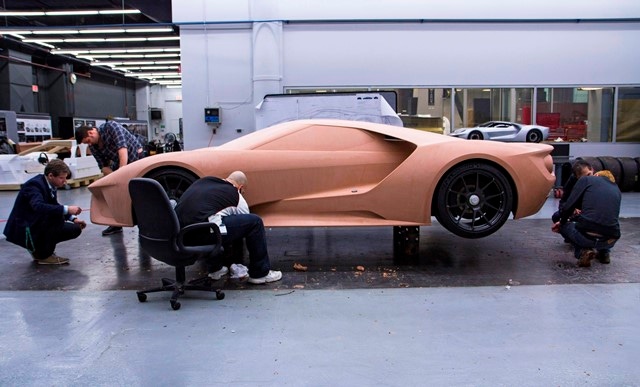Ford GT Supercar Collaborative EffortFord GT Supercar Collaborative Effort
Ford engineers and designers were given just 14 months to design and develop the new GT supercar.

DEARBORN, MI – The Ford GT supercar represents the cumulative knowledge gained by the automaker’s designers and engineers over the course of a decade.
When the last Ford GT was launched in 2005, it was very much a modern supercar, light years beyond the 1960s-era GT40 race car it was fashioned after. Today, both cars pale in comparison to the latest model, unveiled at this year’s North American International Auto Show in Detroit.
“The Ford GT today very different than GT40 or the 2005 GT,” Jamal Hameedi, chief engineer-Ford Performance,” says at a media event here. “The first one was completely a mechanical machine with barely any wires in it. The second car was a modern road car, and had a modern electrical system, fuel injection and anti-lock brakes, but not much more. It was an analog supercar.”
The new Ford GT, set to launch next year, is a rolling computer, containing 84 electronic systems moving over 300 megabytes of data per second, as well as 50 sensors generating 100 gigabytes per second. Additionally, there are 28 microprocessors in the vehicle, Hameedi says.
“There are over 10 million lines of code in the Ford GT,” he says. “The F-22 (fighter jet) has about 2 million, while the Dreamliner (commercial jet) has about 6 to 7 million. So there is a lot of software and it’s all mission critical, there is no reset button. It’s really quite amazing.”
All the computing and sensing power allow for a host of new technologies, including torque vectoring, active aerodynamics and adjustable ride height.
“We’re constantly growing the feature set and there is not end in sight,” Hameedi says.
The level of sophistication of the Ford GT stretches beyond its computer systems. Every part of the car was designed and engineered to be cutting-edge.
The GT was developed in an old milling room in the basement of Ford’s Product Development Center here. Largely abandoned since the 1950s, the area was cleaned out so it could house a small group of engineers and designers who were given just 14 months to bring the supercar to life.
“We realized that we needed a small dedicated space for a small team that was somewhere out of the norm to keep it quiet,” says Moray Callum, vice president-Design. “We had a mixture of a couple of young designers and some more experienced designers. We wanted some of the freshest ideas from the younger designers, but we knew we needed experience to get the car done in record time.”
Dr. EcoBoost on the Case
It was decided the GT would be powered by a special version of Ford’s 3.5L direct-injection turbocharged EcoBoost V-6, also used to power mainstream vehicles such as the F-150 fullsize pickup.
Steve Russ, technical leader for internal-combustion engines, who is called “Dr. EcoBoost” by his peers, says there were both software and hardware changes made to the 3.5L V-6 to make it achieve the GT’s estimated 600 hp.
“Software was key to tune that engine and select the right components,” he says. “We had to put in unique turbos, cams, pistons and rods. We virtually modeled and tested (the engine) with in-house performance-optimization software.”
The relatively small size of the 3.5L V-6, at least compared to the V-8s and V-10s used in other supercars, actually inspired the design team.
“The motor is physically small, so the first thing we did was start to shrink-wrap that motor when we started laying out the passenger compartment,” says Craig Metros, exterior design director-Ford of the Americas. “The more we started to shrink-wrap the surface we realized it was giving us better performance in the wind tunnel.”
Because of the condensed development timeframe, the designers moved from the scale-model stage to full-scale mockups very quickly. Some of the early fullsize models were made out of foam and placed on casters so designers could wheel them outdoors to view the proportions in natural light.
“Early on, the theme of the car was really quite set in terms of volumes and shapes and the flying buttress, as well,” Callum says. “But we had to test in wind tunnels; it was very important to get that right. Aerodynamics are really the prime mover, and you can tell why the exterior shapes are the way they are because of the wind tunnel.”
Callum says he wanted the new Ford GT to look the part, but not be rooted in the past, as was the 2005 GT, which paid homage to the original GT40 racer.
The intricate design was made possible through extensive use of carbon fiber, which not only is lightweight, but also easy to form into complex shapes.
“Carbon fiber is a great material in terms of strength and taking weight out, but for design it really gave us the flexibility to explore some new and modern shapes,” Metros says. “I definitely see us working more with carbon fiber and start using it more in production vehicles.”
Inspiration for the interior was drawn from technological achievements of the modern age, including space travel. Efficiency and performance were key drivers for the interior, with extremely tight packaging dimensions necessitated by canopy aerodynamics. The car’s low roof height mandated a fixed seating position, with seats integrated into a carbon fiber tub.
“Engineering and design went hand in hand,” says Amko Leenarts, global interior design director. “If you’re sitting in the car and reach to the side you’re touching the passenger door, so we had to be as lean and as efficient as possible.”
About the Author
You May Also Like

